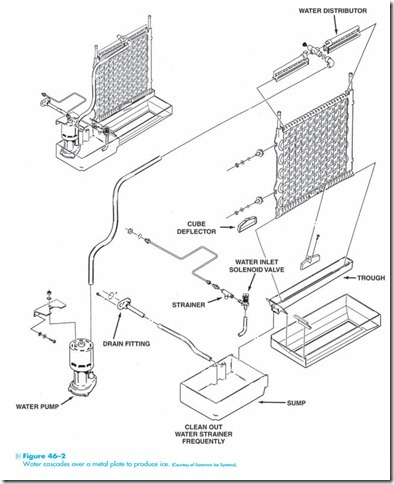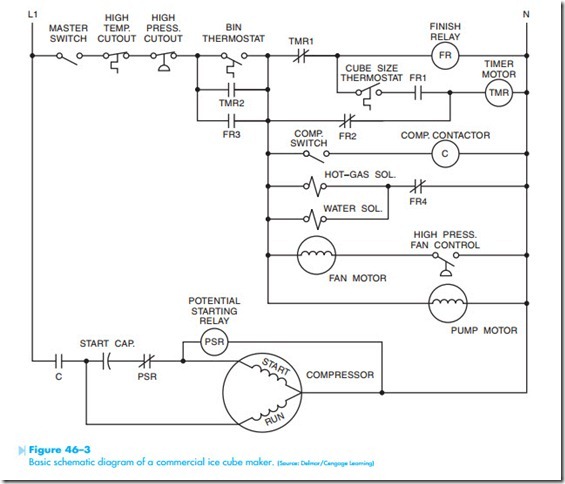Commercial Ice Makers
Commercial ice makers are designed to produce large quantities of ice and are generally found in restaurants, cafeterias, motels, and hotels. Some ice makers produce cubes and others produce flaked ice. The first commercial type ice maker to be discussed is manufactured by Scotsman Company. The basic components of this unit are shown in Figure 46–1. Notice that this unit can be equipped with either an air-cooled or a water-cooled condenser. The water- cooled unit operates much more quietly.
This unit produces ice by cascading water over a metal plate used as the evaporator, Figure 46–2. A water pump provides continuous circulation of water when the compressor is operating. A water distributor, located at the top of the plate, provides an even flow of water over the entire surface of the plate. Excess water is caught by a trough at the bot- tom of the plate and is returned to a sump where
it is recirculated by the pump. Continuous circulation of water produces a clearer ice because pure water freezes faster than impure water. This is not to say that water can be purified by circulating it. The purification is a result of the freezing process. Basically, the water freezes before the impurities and minerals have a chance to freeze. The water, minus the impurities and minerals, is frozen to the evaporator plate and the impurities and minerals are returned to the sump.
After the ice has formed, the harvest cycle begins. At the beginning of this cycle, a hot-gas solenoid valve opens and permits high pressure hot gas to
be diverted to the evaporator plate. This high pressure gas warms the plate, and thaws the surface of the ice that is in contact with it. The combination of the warm plate and the cascading water loosens the ice cubes so that they drop away from the plate and fall into the storage bin below. During the harvest cycle, a water solenoid valve opens and permits fresh water to flow into the sump. This not only refills the sump, but also flushes impurities out the overflow drain.
The basic electrical schematic diagram for this machine is shown in Figure 46–3. There are two manual switches in this circuit. One is the master
switch, and can be used to disconnect power to the entire control circuit. The second is connected in series with the compressor contactor relay coil. This switch can be used to turn off the compressor separately. Two safety switches, the high temperature cutout and the high pressure cutout, are connected in series with the master switch. If either of these switches opens, they will disconnect power to the control circuit.
This circuit also contains two thermostats, the bin thermostat and the cube-size thermostat. The sensor for the bin thermostat is located in the ice storage bin and senses the level of ice. When the ice reaches a high enough level, it touches the sensor and causes the contact to open. This stops the operation of the ice maker at the end of the harvest cycle. The sensor for the cube-size thermostat is mounted on the evaporator plate. When the evaporator plate reaches a low enough temperature, the thermostat contact closes and completes a circuit to the timer motor. The timer contains a set of cam-operated contacts and is used to complete the freeze and harvest cycle.
This circuit also contains a fan motor controlled by a pressure switch that senses the pressure on the high side of the compressor. This fan motor is used only on units with an air-cooled condenser. Because this fan motor is controlled by a pressure switch, it may cycle on and off during the unit’s operation.
For a better understanding of this circuit, it is shown at the beginning of the freeze cycle, Figure 46–4. It is assumed that the master switch and the compressor switch have been closed, and that the bin thermostat contact is closed. A circuit is now completed to the finish relay, FR, causing all FR contacts to change position. The FR3 contact serves as a holding contact to permit completion of the cycle in the event the bin thermostat contact should open. The FR1 contact has closed to permit a current path to the timer motor when the cube size thermostat closes. The compressor contactor coil is energized, which closes its contact and connects the compressor to the line. The pump motor is energized causing water to flow over the evaporator plate. It is also assumed that the high-pressure fan control switch is closed, permitting the condenser fan motor to operate. Notice, however, that the FR4 contact has opened to prevent the hot-gas solenoid and the water solenoid from operating.
After the circuit has operated in this condition for some period of time, the evaporator plate becomes cold enough to permit the cube-size thermostat to close as shown in Figure 46–5. This completes a circuit to the timer motor. The timer is used to complete the cycle in the event the bin thermostat should open.
After the timer has operated for some length of time, the timer contacts will change position as shown in Figure 46–6, starting the harvest cycle. The TMR2 contact closes to maintain a current path around the bin thermostat contact, and the TMR1 contact opens and deenergizes coil FR. When coil FR deenergizes, all of its contacts return to their normal position. The FR2 contact recloses and maintains a current path to the timer motor, permitting it to complete the cycle. When the FR4 contact re- closes, the hot-gas solenoid and water solenoid valves open. As hot gas is circulated through the evaporator plate, it warms and permits the cube size thermostat contact to reopen. The circuit will continue to operate in this condition until the timer completes the cycle and resets both TMR contacts. At this point, the freeze cycle will begin again if the bin thermostat is still closed.


